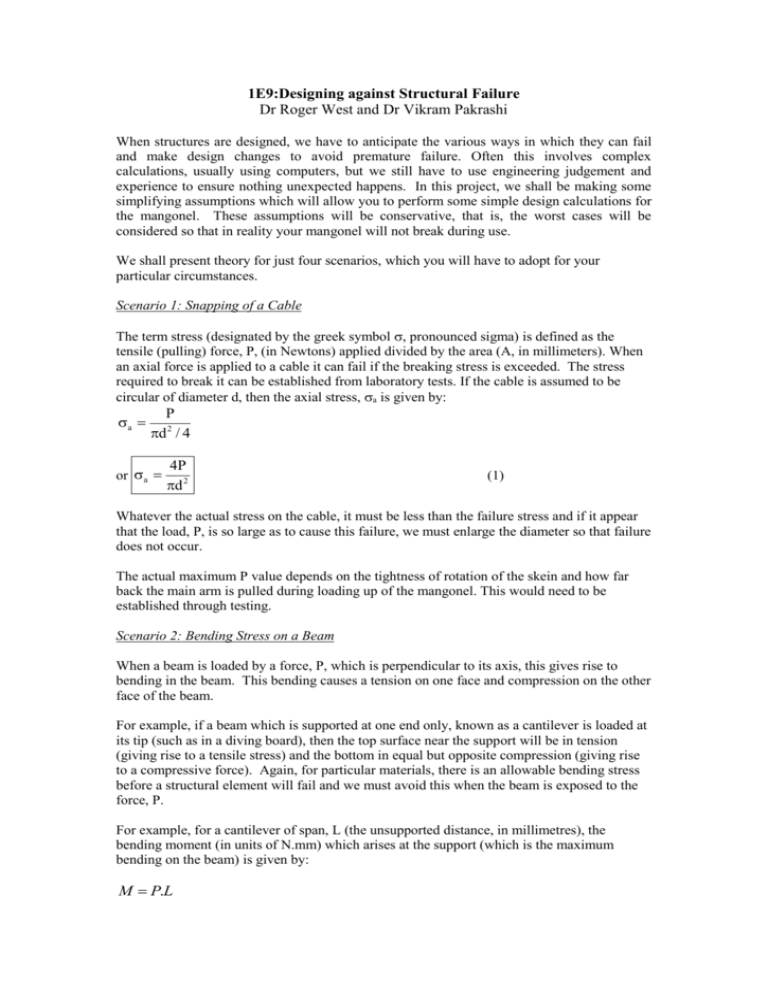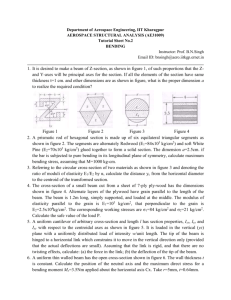1E9:Designing against Structural Failure
advertisement

1E9:Designing against Structural Failure Dr Roger West and Dr Vikram Pakrashi When structures are designed, we have to anticipate the various ways in which they can fail and make design changes to avoid premature failure. Often this involves complex calculations, usually using computers, but we still have to use engineering judgement and experience to ensure nothing unexpected happens. In this project, we shall be making some simplifying assumptions which will allow you to perform some simple design calculations for the mangonel. These assumptions will be conservative, that is, the worst cases will be considered so that in reality your mangonel will not break during use. We shall present theory for just four scenarios, which you will have to adopt for your particular circumstances. Scenario 1: Snapping of a Cable The term stress (designated by the greek symbol , pronounced sigma) is defined as the tensile (pulling) force, P, (in Newtons) applied divided by the area (A, in millimeters). When an axial force is applied to a cable it can fail if the breaking stress is exceeded. The stress required to break it can be established from laboratory tests. If the cable is assumed to be circular of diameter d, then the axial stress, a is given by: a P d 2 / 4 or a 4P d 2 (1) Whatever the actual stress on the cable, it must be less than the failure stress and if it appear that the load, P, is so large as to cause this failure, we must enlarge the diameter so that failure does not occur. The actual maximum P value depends on the tightness of rotation of the skein and how far back the main arm is pulled during loading up of the mangonel. This would need to be established through testing. Scenario 2: Bending Stress on a Beam When a beam is loaded by a force, P, which is perpendicular to its axis, this gives rise to bending in the beam. This bending causes a tension on one face and compression on the other face of the beam. For example, if a beam which is supported at one end only, known as a cantilever is loaded at its tip (such as in a diving board), then the top surface near the support will be in tension (giving rise to a tensile stress) and the bottom in equal but opposite compression (giving rise to a compressive force). Again, for particular materials, there is an allowable bending stress before a structural element will fail and we must avoid this when the beam is exposed to the force, P. For example, for a cantilever of span, L (the unsupported distance, in millimetres), the bending moment (in units of N.mm) which arises at the support (which is the maximum bending on the beam) is given by: M P.L The distribution of stress across the section, assuming a circular beam, is shown in Figure 1, where the assumed distribution is linear. It can be shown that the linear variation in bending stress, b, is given by: b k. y where y is the distance from the middle of the circle and k M I where I is known as the second moment of area, a part-measure of the resistance of the beam to loads. It can be shown that I for a circular cross-section is given by: I d 4 64 Noting that the worst stress occurs at the extreme top/bottom fibre on the beam cross-section (where y = d/2), putting these terms together and simplifying, the actual bending stress can be shown to be approximately: b 32PL d 3 (2) Again, if it appears that, under a particular load with a given span and beam size, the stress will exceed the maximum allowable stress (again, determined by experiment), then we have to use a larger diameter beam to avoid premature failure. The maximum force P which causes the moment M can be ascertained by measuring the maximum tensile force in the cable which pulls back the arm when the mangonel is being loaded. Compressive Stress d d/2 y Tensile Stress Figure 1 Stress distribution across a circular cantilever beam in bending Scenario 3: Shear failure in a dowel If a circular dowel is used to connect two plates together, then the plates have a tendency to slide over one another, shearing the dowel by shearing the circular surface. If there are three plates, as is sometimes the case (see Figure 2), then the dowel is offering two surfaces (at locations a and b in the figure) which must be failed - this is known as double shear failure. Accepting again the simple definition of stress as force divided by area, if a force of P acts to shear the three plate connection, then the expression for the shear stress which arises (using the greek symbol, , pronounced tau), is given by: P P 2. A 2.d 2 / 4 or 2P d 2 (3) Again, a failure shear stress can be determined by testing and the actual shear stress must be less than this value, otherwise the dowel diameter has to be increased. Through testing of a timber dowel (which varies considerably depending on timber type, moisture content, defects, etc) it has been estimated that the failure stress in a typical circular timber beam is 10 N/mm2 (more formally known as Mega Pascals (or MPa) , these days, where a Pascal is defined as 1 N/m2) The maximum force P causing the dowel to resist shear can, again be determined during the rotation of the main arm on the mangonel. Plan Elevation Figure 2: Double shear acting on a plate and dowel arrangement Scenario 4: Impact of rotating mangonel arm on bar stopper When the arm of the mangonel is released on firing , it will rotate very quickly and will have a particular angular velocity (depending on the torque in the skein) when it hits the stopper bar. This is a dynamic (that is, time changing) load where there is a risk this sudden stopping action will cause the main arm to break. In analysing the response of the main arm to this impact load, which is a complex phenomenon, we can simplify the action to two different critical cases: Case 1: The arm is short and the overhang above the bar stopper is negligible: In this case, the rotating main arm hits the bar stopper and stops suddenly, as if the main bar had been impacted by a force P by the bar stopper (Figure 3(a)). If the long term load on the main arm is whatever force is induced in the stopper by the winding up of the skein before it is drawn back by the cable, then this impact force can be easily measured in an experiment: By starting to draw back slowly the main arm on loading, the initial force required to do this (in overcoming the pre-existing torque in the skein), the long term static load can be measured. It is well know that any simple beam which experiences a load which is very suddenly applied (as is the case here when the impact occurs, ignoring the inertia of the mass in the beam) gives rise to a force which is at most twice the static load. That is, its so-called dynamic magnification factor is two. Therefore, for short main arms, we only need to ascertain the unloaded static force which the wound up skein provides, apply a factor of 2 and then apply scenario 2 above as normal to ensure that the main bar will not break when impacting the stopper bar. Case 2: The arm is long and overhangs the bar stopper by an amount, L2 Here, it is not the bar stopper that causes the greatest stress, but the inertia (that is the moving mass) of the overhanging main arm (of length L2, as shown in Figure 3(b)) which causes a significant bending stress in the arm at the bar stopper, due to the cantilever action of the beam beyond this bar. Therefore, by simplifying the complex effect to a cantilever of span L2 which has an initial velocity given by the rotational velocity at the time of impact, it is possible to estimate how far the main arm will deflect before it returns back to its long-term equilibrium position (that is, vertical). The dynamic magnification factor for this case can again, from a conservative point of view, be taken as twice the value of the pseudo-static displacement due to the impact force. It is important here to distinguish between this impact force from what has been discussed in the previous section (case 1). For an impact force, arising due to the accelerating rotational motion of the arm, the pseudo-static displacement is given as: P0 k where P0 is the force due to the impact and k is the stiffness of the distributed mass system of the arm. In the case of a cantilever, k is given by: k 3EI L3 where L is the length of the cantilever (L2 in this case), I is the second moment of area (as given above in scenario 2) and E is the Young’s modulus of elasticity of the material of which the cantilever is comprised. The value of E for timber can be conservatively taken as 1x1010 N/m2. To establish the equivalent load P0 which would generate this maximum deflection under impact we need to consider the fact that the beam is rotating at a particular angular velocity, rad/sec, at the point of impact. This value can be estimated by measurements taken during the electronic component of this project. If we consider the force on impact to be equivalent to dropping the beam from a particular height such that the velocity on impact, v is equivalent to the rotational velocity, as given by v= L2 then, equating kinetic energy on impact with potential energy on dropping from a height (h), that is: 1 mv 2 mgh 2 where g is acceleration due to gravity (9.81 m/s2). Hence the equivalent drop height which delivers the appropriate speed on impact is h v2 2g It can be shown that the dynamic magnification factor under this impact is given by DMF 1 1 2 h stat (4) where stat is given by stat P0 L32 3EI where P0 is equals mgL2. This DMF can be applied to the static stress for a cantilever under its own weight (=A, where is the weight density of the material and A is the cross sectional area). This stress is given by static 16L22 d3 L2 Input Force Stopper Main Arm L1 L1 Torque Figure 3: (a) Approximate impact force on a short main arm and (b) approximate impact effect on a long main arm, where only the cantilever is considered. RPW & VP: November 2007







